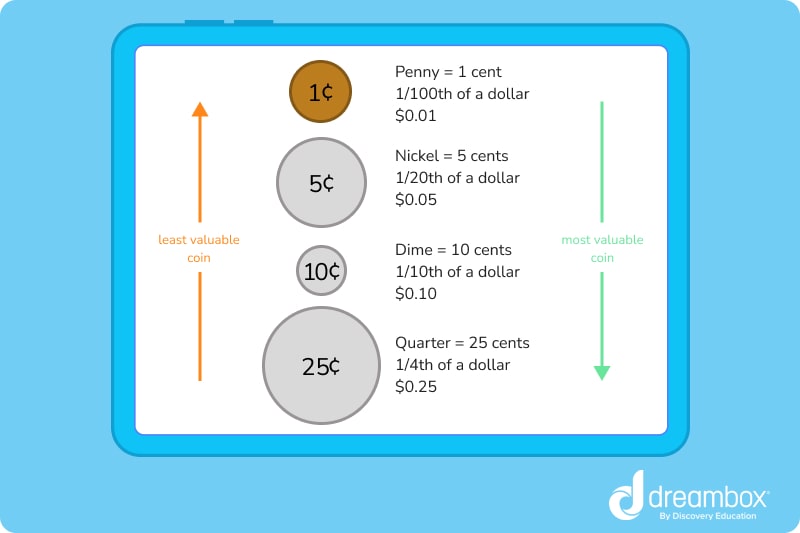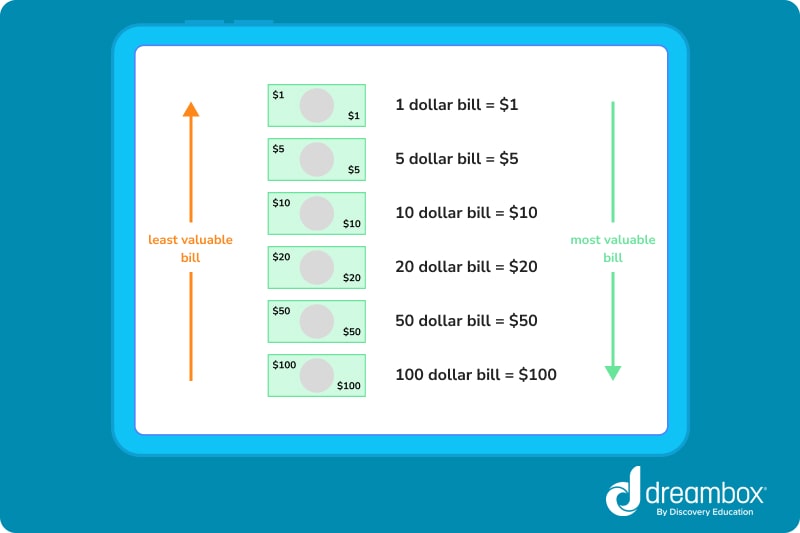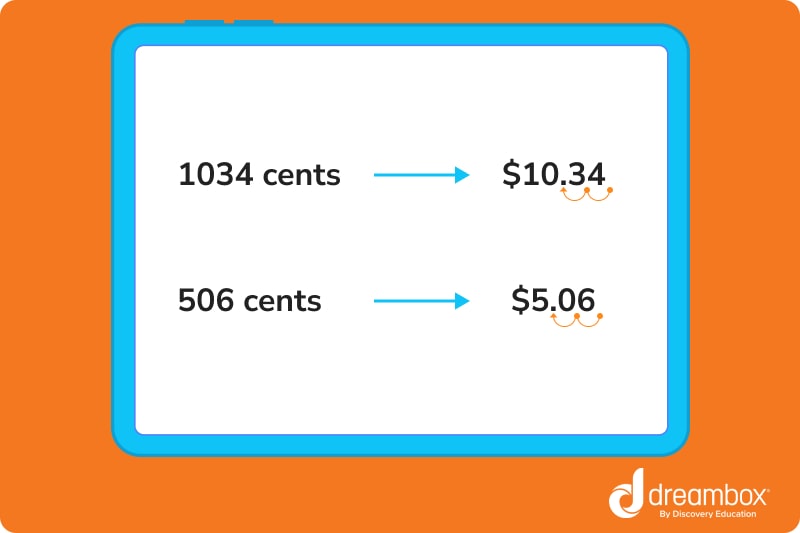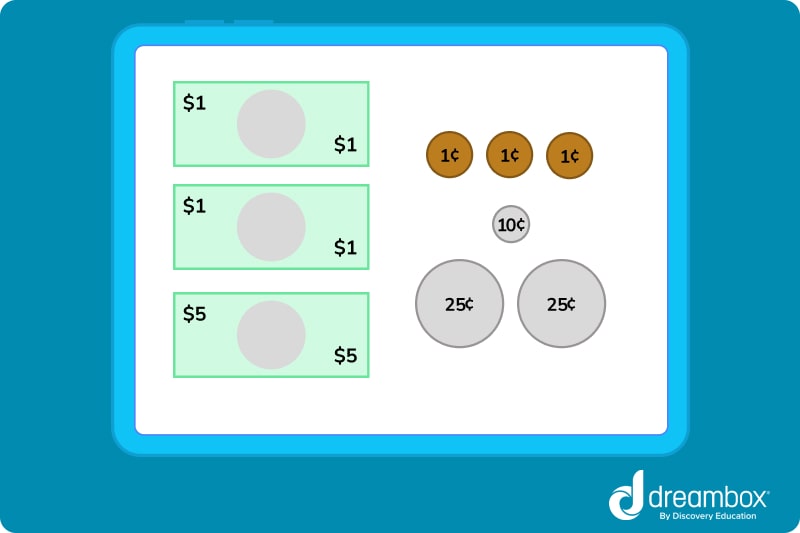How to Count Money
The quick and easy guide for teaching your kids how to count money

Author
Tess Loucka
Published:
Oct 2024
Key takeaways
- • One dollar is worth 100 cents. Once you have more than 99 cents, money should be written in dollar terms.
- • To convert cents to dollars, move the decimal point over to the left by 2 spaces.
- • To count money faster, use the “counting on” method. Start with the greatest value and gradually move on to the smaller values as you go.
Have you ever heard the saying “money makes the world go ‘round”?
It’s a fact of life that we all become aware of at a young age. From the first time we beg our parents for a piece of candy or a new toy and hear, “that’s too expensive,” to when we earn our first few dollars of allowance for washing the dishes the importance of money is carved into our minds.
Once you understand that money has value, the next thing you need to know is how to manage it. That’s where knowing how to count money comes in handy!
What Kids Should Know Before Counting Money
Counting to 100
When counting money, understanding how to count to 100 is foundational. The dollar (worth 100 cents) should be used as the reference point so if your child can’t count to 100, start there. Every amount of money is either a multiple of the dollar or a fraction of the dollar, whether you’re referring to dollars or cents.
Addition
Counting money is all about addition. Without a good understanding of how addition works, being able to calculate the combined values of coin and bill combinations will be very difficult. So, a solid foundation in addition is key.
Skip-counting by 5s, 10s, 20s, and 25s
Skip-counting is the process of counting up by multiples of a number.
Pennies and dollar bills are the only money that can be counted by 1s. Once you have nickels, dimes, quarters, $5 bills, $10 bills, $20 bills, etc. knowing how to skip-count is key.
If you have 5 nickels for example, rather than counting by 1s, you’d want to count by 5s, since a nickel is worth 5 cents, $0.05. To count 5 nickels, you’d skip-count by 5s: 5, 10, 15, 20, 25. In total, you’d have 25 cents, $0.25.
Table of contents
Access more math practice with DreamBox
Turn math into playtime with DreamBox Math
DREAMBOX MATH
Get started for FREE today!

Values of Coins and Bills
You can’t learn how to count coins and bills without knowing their values. Use the chart below to learn the value of each type of money in use in the US today.
Values of Coins
Least valuable coin
Penny = 1 cent, 1/100th of a dollar, $0.01.
Nickel = 5 cents, 1/20th of a dollar, $0.05.
Dime = 10 cents, 1/10th of a dollar, $0.10.
Quarter = 25 cents, 1/4th of a dollar, $0.25.
Most valuable coin

Values of Dollar Bills
Least Valuable Bill
1 dollar bill = $1
5 dollar bill = $5
10 dollar bill = $10
20 dollar bill = $20
50 dollar bill = $50
100 dollar bill = $100
Most valuable bill


The math program that drives results
Get started today!
DreamBox adapts to your child’s level and learning needs, ensuring they are appropriately challenged and get confidence-building wins.
How to Count Money
Once the foundational math skills of addition, skip counting and the value of dollars and cents are mastered, we can move forward with counting money.
Counting Coins
Money is counted in dollars and cents. Start by understanding how to count coins. When counting coins, remember that every 100 cents is equal to one dollar. One hundred cents can be broken down in many ways depending on what coins you have in front of you. One hundred cents can be made up of:
- 4 quarters
- 10 dimes
- 20 nickels
- 100 pennies
To break things down even further, more valuable coins can be broken up into coins of smaller value:
- A quarter can be broken up into 2 dimes and 1 nickel, 5 nickels, or 25 pennies
- A dime can be broken up into 2 nickels or 10 pennies
- A nickel can be broken up into 5 pennies
Once you understand how change can be broken down, practice adding different coins together.
Coin Counting Tip
- Always start with the coins of greatest value and work your way down. For example, if you have 3 nickels, 1 dime, 2 quarters, and 5 pennies, count the quarters first! After the quarters, the second most valuable coin is the dime. Then comes the nickel. The penny comes last.
2 quarters = 25 cents + 25 cents = 50 cents
1 dime = 10 cents
3 nickels = 5 cents + 5 cents + 5 cents = 15 cents
5 pennies = 1 cent + 1 cent + 1 cent + 1 cent + 1 cent = 5 cents
50+10+15+5 = 80
You’d have 80 cents!
Finally, work on converting cents to dollars. When coin counting, converting cents to dollars is easy — just move the decimal point over to the left by two space:
- 1034 cents becomes $10.34
- 506 cents becomes $5.06

Counting Bills
Money counting with bills is very similar to counting with coins. However, this time you’re only working with dollars — no cents.
The smallest bill, the $1 bill, is the only bill that cannot be broken down into smaller bills.
- The $5 bill can be broken up into five $1 bills.
- The $10 bill can be broken up into two $5 bills, or ten $1 bills.
- The $20 bill can be broken up into two $10 bills, four $5 bills, or twenty $1 bills.
- The $50 bill can be broken up into two $20 bills and one $10 bill, five $10 bills, ten $5 bills, or fifty $1 bills.
- The $100 bill can be broken up into two $50 bills, five $20 bills, ten $10 bills, twenty $5 bills, one-hundred $1 bills, or a number of other bill combinations!
Knowing how money can be broken up comes in handy when making purchases and counting change. But you aren’t always going to be counting coins and bills separately. Sometimes, you’ll have to count them at the same time!
Let’s take a look at how that works.
Adding Coins and Bills
To add both coins and bill, follow these steps:
- Count coins first
- Convert the coin total into dollars
- Add up the bills
- Add the two values together

Techniques for Counting Money
To make counting money easier, there are two additional techniques you might want to give a try: “counting on” and “grouping”.
Counting "On"
Start with the largest values first and progressively count the smaller ones. Let’s say you have one $20 bill, one $5 bill, and three $1 bills. This should be your counting process: $20 + $5 + $3 = $28.
"Grouping"
The “grouping” technique is best for larger amounts of money.
With the “grouping” technique, you group like coins and bills together. Do your best to group the coins together in groups of 100 cents. Add up the coins and the bills separately, then add the two values together to get your total value.
Practice Problems
You will have $6 left over. The remainder can be represented by 1 $5 bill and 1 $1 bill, or 6 $1 bills.
Parent Guide
- 1. Add the coins and bills separately, then add them together. Three quarters = $0.75, two nickels = $0.10, one penny = $0.01. The coins are worth $0.86. With the $5 bill, that’s $5.86.
- 2. To calculate the money you will have left over, do $20-$14 to get $6. Next, find the ways $6 can be broken up using bills. $6 can be broken up into a $5 bill and a $1 bill because 5+1=6. $6 can also be broken up into 6 $1 bills because 1+1+1+1+1+1=6.
- 3. Add up all the coin values. The one equal to 100 cents is the correct answer.
FAQs about Money Counting
Start with the largest values first and gradually work your way down to the smallest values.
Practice skip-counting using the values of common coins and bills. Grab a handful of coins and bills and use skip-counting to determine their total value.
If you need extra practice learning how to count money playing board games like Monopoly or Life are great ways to engage your child. You can also try online math games or math apps that build counting and addition skills for additional support.
Take at home math practice to the next level
Empowering parents and educators to make math practice more impactful. Plus, your kids will love it.


About the Author
Tess Loucka
Tess Loucka discovered her passion for writing in high school and has not stopped writing since. Combined with her love of numbers, she became a math and English tutor, focusing on middle- and high-school-level topics. Since graduating from Hunter College, her goal has been to use her writing to spread knowledge and the joy of learning to readers of all ages.

